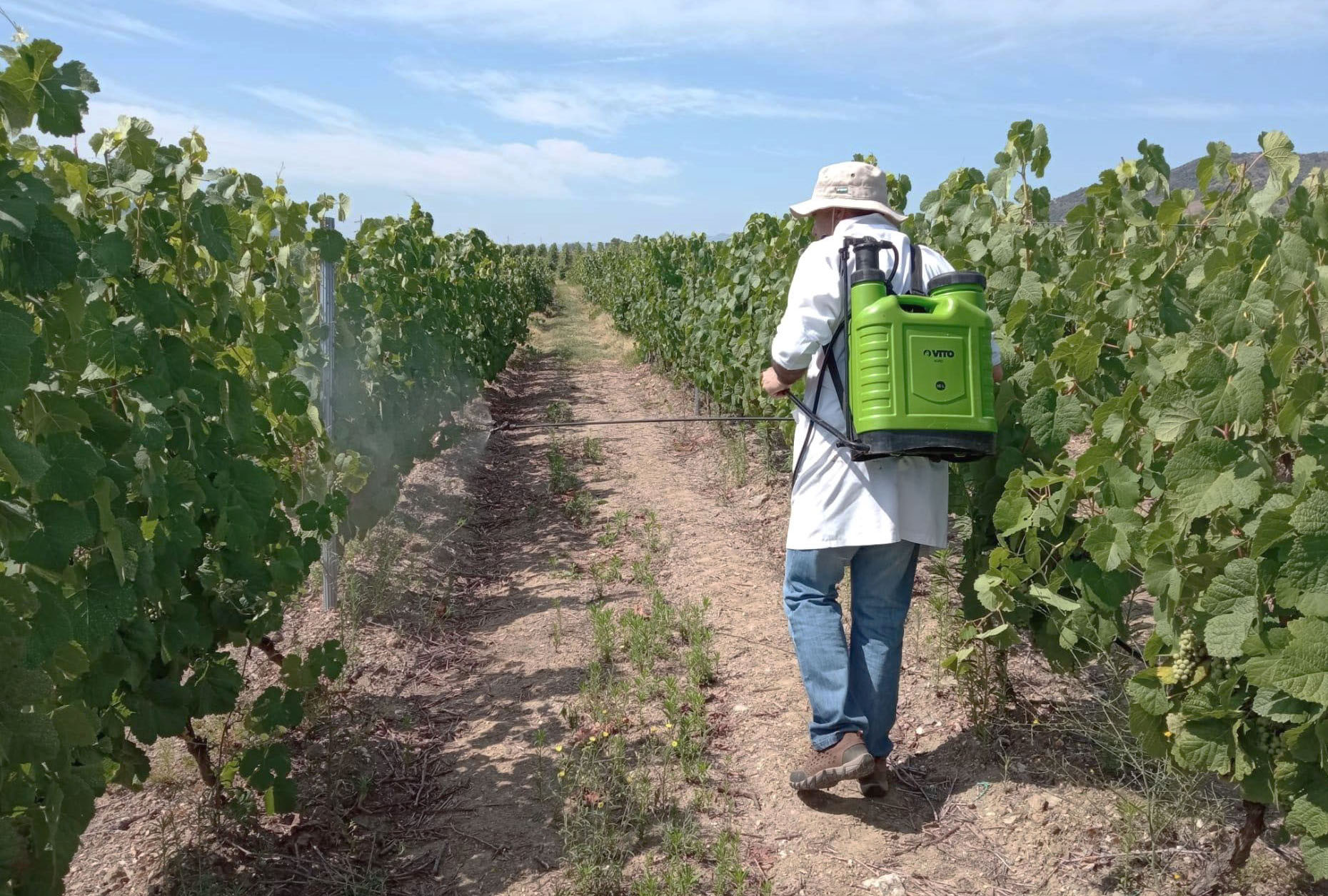Efeito da aplicação foliar de silício na cv. Touriga franca na região demarcada do Douro - Bibliografia
Texto por: Lia-Tânia Dinis1,2, Natália Mota3, Sara Bernardo1,2, António Ribeiro4, José Moutinho-Pereira1,2
1 Centro de Investigação e Tecnologias Agroambientais e Biológicas (CITAB), Universidade de Trás-os-Montes e Alto Douro (UTAD)
2 Inov4Agro - Instituto de Inovação, Capacitação e Sustentabilidade da Produção Agroalimentar, Universidade de Trás-os-Montes e Alto Douro (UTAD)
3 Mestranda em Enologia e Viticultura - Escola de Ciências Agrárias e Veterinárias, Universidade de Trás-os-Montes e Alto Douro (UTAD)
4 Centro de Investigação de Montanha (CIMO), Instituto Politécnico de Bragança (IPB)
O clima quente e seco constitui um enorme desafio para a viticultura portuguesa manter os seus padrões de produtividade e qualidade. A escassez de recursos hídricos é limitante para a rega, tornando essencial adotar medidas alternativas de baixo-custo e ambientalmente sustentáveis, para mitigar os efeitos negativos FIGURA 1. Campo de ensaio em estudo com cv. Touriga Franca, no Douro Superior, Região Demarcada do Douro das mudanças climáticas. Neste estudo avaliou-se o efeito do silício na tolerância ao stresse estival na cv. Touriga Franca, numa vinha comercial na Região Demarcada do Douro. Os resultados revelaram que plantas com silício apresentaram uma taxa fotossintética superior às plantas não regadas e semelhante às plantas com rega deficitária (25% da ETc). À maturação, o tratamento com silício resultou em frutos com maiores valores de flavonóides, antocianinas, álcool provável, pH e brix°. Os resultados reforçam a ideia de que a aplicação de silício pode ajudar as plantas a tolerar o stresse estival e poderá ser uma alternativa eficaz às estratégias de rega deficitária.

BIBLIOGRAFIA
Al-Wasfy, M.M.M. The Synergistic Effects of Using Silicon with Some Vitamins on Growth and Fruiting of Flame Seedless Grapevines. Stem Cell 5(1), (2014).
Carvalho, A., et al., Effects of heat stress in the leaf mitotic cell cycle and chromosomes of four wine-producing grapenive varieties., Protoplasma 255, (2018)1725–1740.Dambergs R.G. et al., Rapid measurement of methylcellulose precipitable tannins using ultraviolet spectroscopy with chemometrics: application to red wine and inter-laboratory calibration transfer. Appl Spectrosc 66(6), (2012) 656–64.
Dinis, L.T., et al., Kaolin exogenous application boosts antioxidant capacity and phenolic content in berries and leaves of grapevine under summer stress. J Plant Physiol 191, (2016) 45–53.
Dinis, L.-T., et al., Improvement of grapevine physiology and yield under summer stress by kaolin-foliar application: water relations, photosynthesis and oxidative damage. Photosynthetica 56, (2018) 641–651.
Farahani, H., et al., Effect of Foliar-Applied Silicon on Flower Yield and Essential Oil Composition of Damask Rose (Rosa damascena Miller) under Water Deficit Stress, Silicon 13, (2020) 4463–4472.
Gomes, T.M., et al., Changes in vineyard productive attributes and phytochemical composition of sauvignon blanc grape and wine induced by the application of silicon and calcium. J. Sci Food Agric 100, (2019) 1547–1557.
Granato, D., et al., Characterization of conventional, biodynamic, and organic purple grape juices by chemical markers, antioxidant capacity, and instrumental taste profile. J Food Sci 80, (2015) C55–65.
Grimplet, J., et al., Tissue-specific mRNA expression profiling in grape berry tissues. BMC Genom. 8, (2007) 187.
Hattori, T., et al., Short term stomatal responses to light intensity changes and osmotic stress in sorghum seedlings raised with and without silicon, Environ. Exp. Bot 60, (2007) 177–182.
Jones, G.V., et al., Climate change and global wine quality. Climate Change,73, (2005) 319–343.
Karagiannis, E., et al., Silicon influenced ripening metabolism and improved fruit quality traits in apples. Plant Physiol. Biochem 166, (2021) 270–277.
Kaya, K., Tuna, L., Higgs, D. Effect of silicon on plant growth and mineral nutrition of maize grown under water-stress conditions, J. Plant Nutr 29, (2006) 1469–1480.
Kennedy J.A. Matthews M.A., Waterhouse A.L. Effect of maturity and vine water status on grape skin and wine flavonoids. Am. J. Enol. Vitic 53, (2002) 268–274.
Lee, J., et al., Determination of total monomeric anthocyanin pigment content of fruit juices, beverages, natural colorants, and wines by the pH differential method: collaborative study. J AOAC Intern 88(5) (2005) 1269–1278.
Moussa, H.R. Influence of exogenous application of silicon on physiological response of salt-stressed maiz e (Zea mays L.). Inter. J Agric. Biol 8 (2006) 293–297.
OIV, 2003. Compendium of internationals methods of wine and must analysis., in: OIV (Ed.), Paris.
Price, M.L., Scoyoc, S.V., Butler, L.G. A Critical Evaluation of the Vanillin Reaction as an Assay for Tannin in Sorghum Grain. J. Agric. Food Chem 26 (1978).
Qin, L., et al., The influence of silicon application on growth and photosynthesis response of salt stressed grapevines (Vitis vinifera L.). Acta Physiol. Plant 38(3), (2016) 1–9.
Roby, G., et al., Berry size and vine water deficits as factors in winegrape composition: anthocyanins and tannins. Aust. J Grape Wine Res 10 (2004) 100–107.
Rodrigues, M.J., et al. Unravelling the antioxidant potential and the phenolic composition of different anatomical organs of the marine halophyte Limonium algarvense. Ind. Crops Prod 77 (2015) 315–322.
Spayd, S.E., Tarara, J.M., Mee, D.L., Ferguson, J.C. Separation of sunlight and temperature effects on the composition of Vitis vinifera cv. Merlot berries. Am. J. Enol. Vitic. 53 (2002) 171–182.
Tarara, J.M., Lee, J., Spayd, S.E., Scagel, C.F. Berry temperature and solar radiation alter acylation, proportion, and con-centration of anthocyanin in Merlot grapes. Am. J. Enol. Vitic 59 (2008) 235–247.